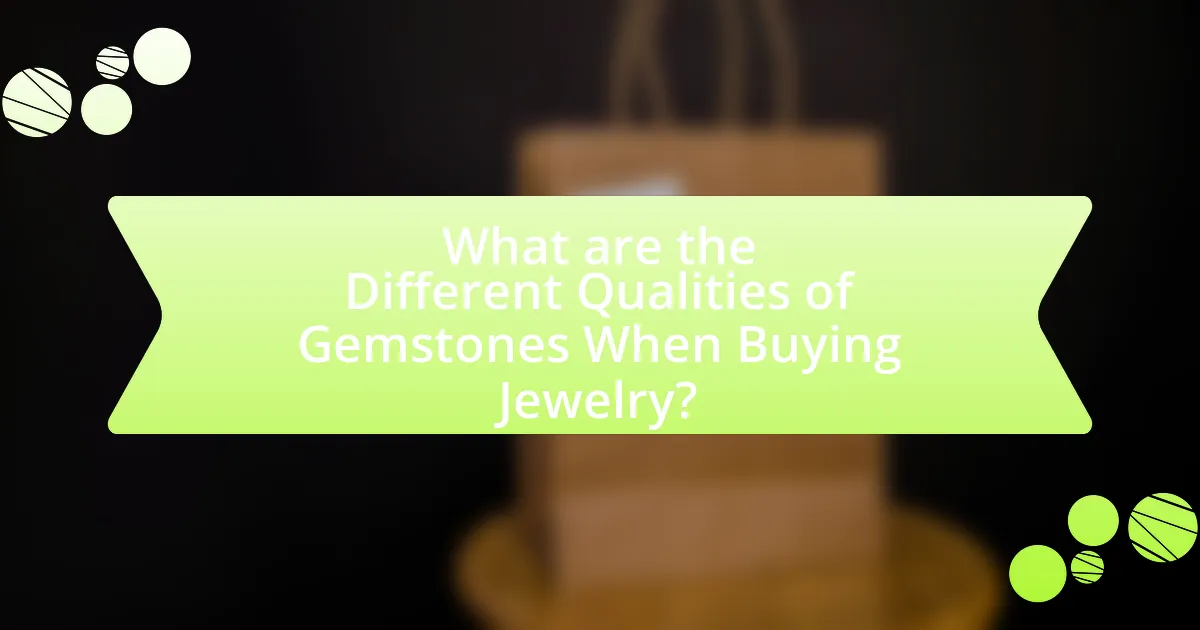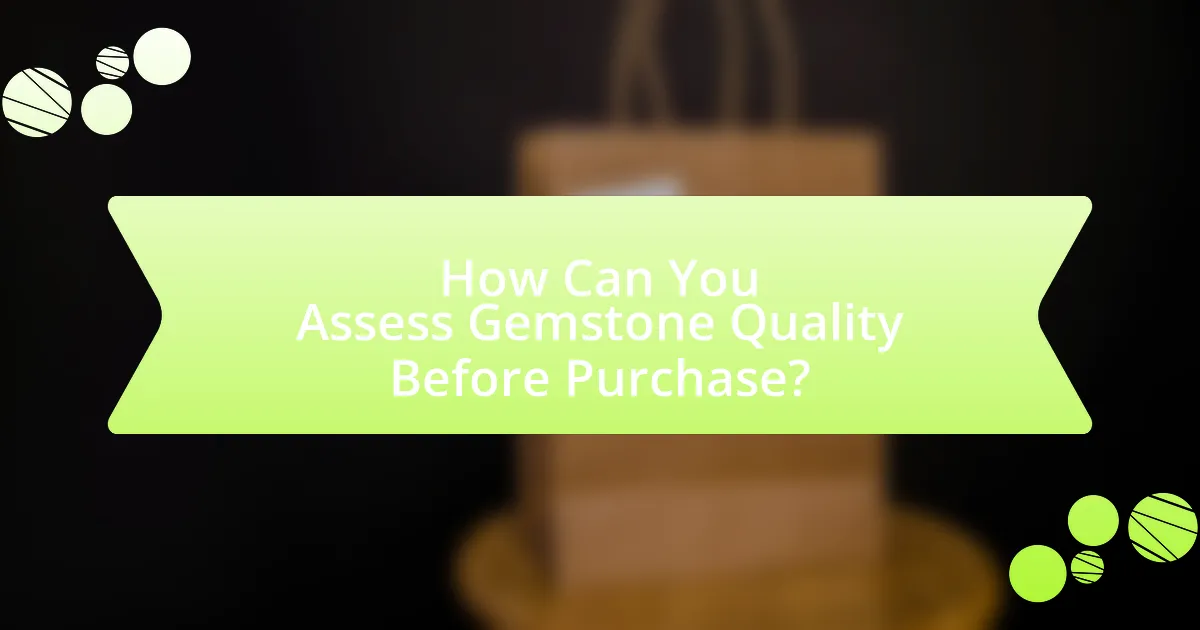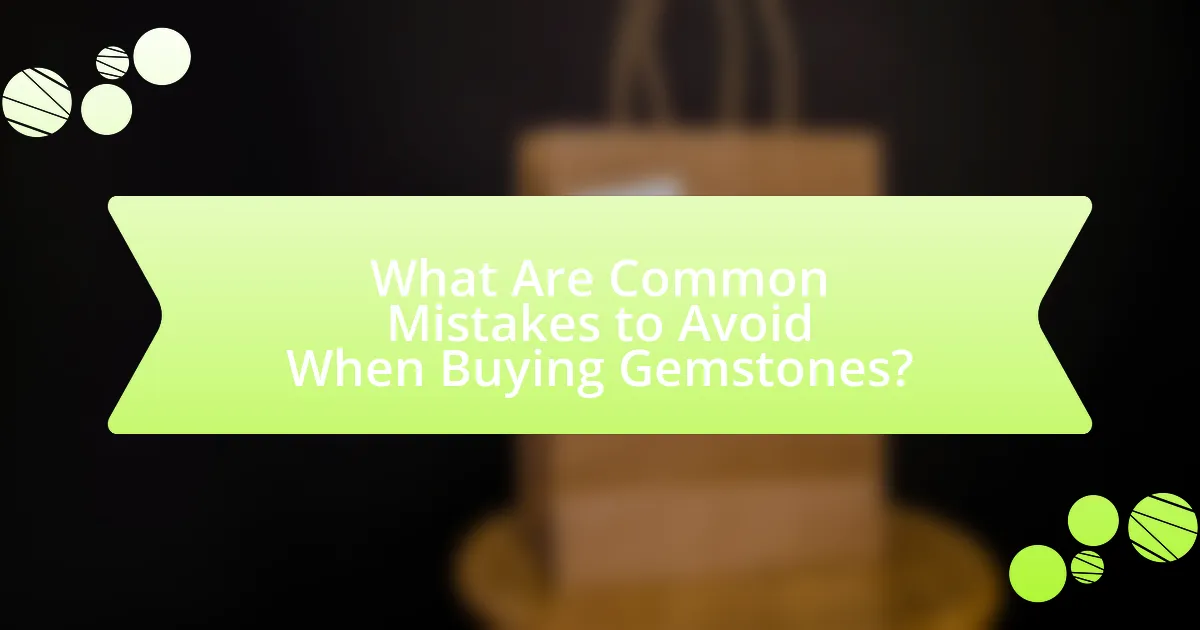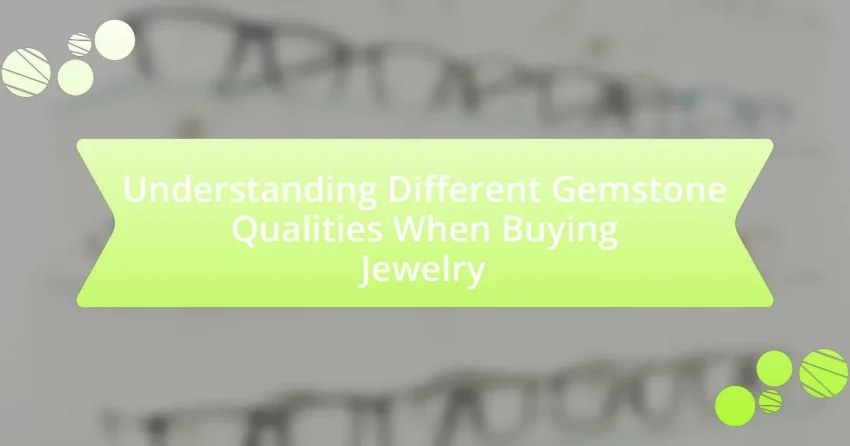The article focuses on understanding the various qualities of gemstones that are crucial when purchasing jewelry, specifically highlighting clarity, color, cut, carat weight, and origin. It explains how these factors impact the overall value and desirability of gemstones, detailing the significance of clarity in appearance, the importance of color saturation, and the role of cut in enhancing brilliance. Additionally, the article discusses the tools and certifications necessary for evaluating gemstone quality, the risks associated with unverified sellers, and common mistakes to avoid during the buying process. Overall, it provides essential insights for consumers to make informed decisions in the gemstone market.

What are the Different Qualities of Gemstones When Buying Jewelry?
The different qualities of gemstones when buying jewelry include clarity, color, cut, carat weight, and origin. Clarity refers to the presence of internal or external flaws, with higher clarity indicating a more valuable gemstone. Color is assessed based on hue, saturation, and tone, with vivid colors typically being more desirable. The cut affects how well a gemstone reflects light, influencing its brilliance and overall appearance. Carat weight measures the size of the gemstone, with larger stones generally being more valuable. Lastly, the origin can impact a gemstone’s value, as certain locations are known for producing higher-quality stones. These qualities are essential for determining the overall value and desirability of gemstones in jewelry.
How do Gemstone Qualities Impact Jewelry Value?
Gemstone qualities significantly impact jewelry value through factors such as clarity, color, cut, and carat weight. Clarity refers to the presence of inclusions or blemishes; higher clarity typically results in greater value, as seen in diamonds where flawless stones can command prices up to ten times higher than those with visible inclusions. Color affects value as well; for example, deep, vivid colors in gemstones like sapphires and emeralds are more desirable and thus more valuable. The cut influences how well a gemstone reflects light; expertly cut stones enhance brilliance and can increase value substantially. Lastly, carat weight directly correlates with value, as larger gemstones are rarer and more sought after, with prices often increasing exponentially with size. Collectively, these qualities determine the overall market value of the jewelry piece.
What are the key factors that determine gemstone quality?
The key factors that determine gemstone quality are color, clarity, cut, and carat weight. Color refers to the hue, tone, and saturation of the gemstone, which significantly affects its visual appeal and value; for example, a deep blue sapphire is generally more valuable than a pale one. Clarity measures the presence of internal or external flaws, with higher clarity indicating fewer imperfections, thus enhancing the stone’s brilliance. Cut describes how well the gemstone has been shaped and faceted, influencing its light performance; an expertly cut diamond can reflect light more effectively than a poorly cut one. Carat weight quantifies the size of the gemstone, with larger stones typically being rarer and more valuable. Collectively, these factors are often referred to as the “Four Cs” in gemology, and they play a crucial role in determining the overall quality and market value of gemstones.
How does clarity affect the overall appearance of a gemstone?
Clarity significantly impacts the overall appearance of a gemstone by determining how transparent and free of inclusions the stone is. Higher clarity levels result in a more visually appealing gemstone, as they allow more light to pass through, enhancing brilliance and sparkle. For example, diamonds graded as “Flawless” or “Internally Flawless” exhibit exceptional clarity, leading to a more desirable appearance compared to stones with visible inclusions or blemishes. This is supported by the Gemological Institute of America (GIA), which states that clarity is one of the key factors influencing a gemstone’s value and aesthetic appeal.
Why is Color Important in Gemstone Selection?
Color is crucial in gemstone selection because it significantly influences a gemstone’s value and aesthetic appeal. The hue, saturation, and tone of a gemstone determine its desirability; for instance, a vivid blue sapphire is more sought after than a pale one. Research indicates that color accounts for up to 80% of a gemstone’s overall value, as seen in the market for colored diamonds, where intense colors can command prices exponentially higher than their lighter counterparts. Therefore, understanding color characteristics is essential for making informed purchasing decisions in jewelry.
What are the different color grading systems for gemstones?
The different color grading systems for gemstones include the Gemological Institute of America (GIA) system, the International Gemological Institute (IGI) system, and the American Gem Society (AGS) system. The GIA system uses a scale from D (colorless) to Z (light yellow or brown) to evaluate diamonds, while colored gemstones are graded based on hue, tone, and saturation. The IGI system also assesses color but may include additional factors like clarity and cut in its overall grading. The AGS system employs a numerical scale for color grading, focusing on the quality of the hue and its intensity. Each of these systems provides a standardized method for evaluating gemstone color, ensuring consistency and reliability in the market.
How does color saturation influence gemstone desirability?
Color saturation significantly influences gemstone desirability by determining the intensity and richness of a gemstone’s color. Higher saturation levels typically result in more vibrant and appealing colors, which are often more sought after in the market. For example, in gemstones like sapphires and rubies, those with deep, saturated colors command higher prices due to their visual impact and rarity. Research indicates that consumers are willing to pay up to 20% more for gemstones with higher saturation compared to those with muted colors, highlighting the direct correlation between saturation and perceived value.
What Role Does Cut Play in Gemstone Quality?
The cut of a gemstone significantly influences its quality by affecting its brilliance, fire, and overall aesthetic appeal. A well-executed cut enhances light performance, allowing the gemstone to reflect and refract light optimally, which results in a more vibrant appearance. For instance, diamonds are graded on cut quality using a scale that considers proportions, symmetry, and polish; a higher cut grade can increase a diamond’s value by up to 50%. Therefore, the cut is a critical factor in determining both the visual impact and market value of a gemstone.
How does the cut of a gemstone affect its brilliance?
The cut of a gemstone significantly affects its brilliance by determining how light interacts with the stone. A well-executed cut maximizes the reflection and refraction of light, enhancing the gemstone’s sparkle and overall visual appeal. For example, diamonds are often cut in specific shapes, such as the round brilliant cut, which features 58 facets designed to optimize light performance. Research indicates that the quality of the cut can influence a diamond’s perceived brightness by up to 50%, demonstrating the critical role of cut in achieving maximum brilliance.
What are the different types of gemstone cuts available?
The different types of gemstone cuts available include round, princess, emerald, oval, pear, marquise, and cushion cuts. Each cut is designed to enhance the stone’s brilliance and overall appearance. For instance, the round cut is the most popular and maximizes light reflection, while the emerald cut features a rectangular shape with step-like facets that emphasize clarity. The princess cut combines the brilliance of the round cut with a square shape, making it a favorite for modern jewelry. Each cut serves a specific aesthetic purpose, influencing the gemstone’s visual appeal and market value.

How Can You Assess Gemstone Quality Before Purchase?
To assess gemstone quality before purchase, examine the four key factors: color, clarity, cut, and carat weight. Color refers to the hue, saturation, and tone of the gemstone, with vibrant colors typically indicating higher quality. Clarity measures the presence of inclusions or blemishes; gemstones with fewer imperfections are generally more valuable. The cut affects how well the gemstone reflects light, with well-cut stones exhibiting brilliance and sparkle. Carat weight indicates the size of the gemstone, with larger stones often being more desirable. According to the Gemological Institute of America, these criteria are essential for determining the overall quality and value of gemstones, ensuring informed purchasing decisions.
What Tools Can Help You Evaluate Gemstone Quality?
To evaluate gemstone quality, essential tools include a loupe, a gem scale, and a refractometer. A loupe, typically 10x magnification, allows for detailed inspection of clarity and inclusions. A gem scale provides precise weight measurements, which are crucial for determining value, as gemstone pricing often correlates with carat weight. A refractometer measures the refractive index, helping to identify the gemstone type and assess its quality based on light performance. These tools are widely used by gemologists and jewelers to ensure accurate evaluations of gemstones.
How do gemological tools enhance your buying experience?
Gemological tools enhance the buying experience by providing accurate assessments of gemstone quality, including clarity, color, cut, and carat weight. These tools, such as refractometers, microscopes, and spectroscopes, allow buyers to verify the authenticity and value of gemstones, ensuring informed purchasing decisions. For instance, a gemological microscope can reveal inclusions and surface blemishes that affect a stone’s value, while a refractometer measures the refractive index, confirming the type of gemstone. This level of detail empowers consumers to make confident choices, reducing the risk of purchasing inferior or misrepresented stones.
What certifications should you look for when buying gemstones?
When buying gemstones, you should look for certifications from reputable gemological laboratories such as the Gemological Institute of America (GIA), American Gem Society (AGS), and International Gemological Institute (IGI). These certifications provide detailed reports on the gemstone’s quality, including its cut, color, clarity, and carat weight, ensuring that the buyer receives an accurate assessment of the stone’s value and authenticity. For example, GIA is widely recognized for its rigorous grading standards and is considered the gold standard in the industry, providing buyers with confidence in their purchase.
Why is it Important to Buy from Reputable Sources?
Buying from reputable sources is crucial because it ensures the authenticity and quality of gemstones. Reputable sellers typically provide certifications and guarantees that verify the origin and characteristics of the stones, reducing the risk of purchasing counterfeit or low-quality gems. For instance, the Gemological Institute of America (GIA) is a recognized authority that grades gemstones based on specific criteria, ensuring buyers receive accurate information about their purchases. This level of transparency and trust is essential for making informed decisions in the jewelry market.
What are the risks of purchasing gemstones from unverified sellers?
Purchasing gemstones from unverified sellers poses significant risks, including the potential for acquiring counterfeit or misrepresented stones. Unverified sellers may lack the necessary credentials or expertise to accurately assess gemstone quality, leading to the sale of synthetic stones as natural ones or stones with undisclosed treatments that affect their value. According to a report by the Gemological Institute of America, approximately 30% of gemstones sold in unregulated markets are either synthetic or treated without proper disclosure. This lack of transparency can result in financial loss and diminished trust in the gemstone market.
How can you identify trustworthy jewelers?
To identify trustworthy jewelers, verify their credentials, reputation, and customer reviews. Trustworthy jewelers typically possess certifications from recognized organizations, such as the Gemological Institute of America (GIA) or the American Gem Society (AGS), which indicate their expertise in gemstones and jewelry. Additionally, reputable jewelers often have positive customer feedback, which can be found on platforms like Yelp or Google Reviews, reflecting their reliability and quality of service. Engaging with jewelers who offer transparent information about their products, including detailed descriptions and certifications for gemstones, further confirms their trustworthiness.

What Are Common Mistakes to Avoid When Buying Gemstones?
Common mistakes to avoid when buying gemstones include neglecting to verify the gemstone’s authenticity, failing to understand the 4 Cs (cut, color, clarity, carat weight), and not considering the source of the gemstone. Authenticity verification is crucial, as many gemstones are treated or synthetic; for instance, approximately 80% of diamonds are treated in some way. Understanding the 4 Cs helps buyers assess quality and value accurately; for example, a well-cut diamond can appear larger and more brilliant than a poorly cut one of the same carat weight. Additionally, knowing the source is important because gemstones from certain regions may have better reputations for quality and ethical sourcing, such as Colombian emeralds being highly valued for their color and clarity.
How Can You Avoid Overpaying for Gemstones?
To avoid overpaying for gemstones, conduct thorough research on gemstone quality and market prices before making a purchase. Understanding the four Cs—cut, color, clarity, and carat weight—enables buyers to assess the value of gemstones accurately. For instance, a well-cut diamond can appear larger and more brilliant than a poorly cut one of the same carat weight, significantly affecting its price. Additionally, comparing prices from multiple reputable jewelers and utilizing online resources like the Gemological Institute of America (GIA) can provide insights into fair market values. This approach ensures informed decisions and helps prevent excessive spending on gemstones.
What are the signs of overpriced gemstones?
Signs of overpriced gemstones include inflated pricing compared to market value, lack of certification from reputable gemological laboratories, and exaggerated claims about rarity or quality. For instance, if a gemstone is priced significantly higher than similar stones of the same quality and size, it may indicate overpricing. Additionally, gemstones without certification from recognized organizations like the Gemological Institute of America (GIA) may lack verified quality assessments, making them potentially overpriced. Lastly, sellers who emphasize the gemstone’s supposed uniqueness without providing evidence or certification may be attempting to justify an inflated price.
How can market trends affect gemstone pricing?
Market trends significantly influence gemstone pricing by dictating supply and demand dynamics. When consumer interest in specific gemstones rises, prices typically increase due to heightened demand. For instance, the popularity of colored gemstones like sapphires and emeralds has surged in recent years, leading to a corresponding rise in their market prices. Conversely, if a gemstone falls out of favor, its price may decline as demand diminishes. Historical data shows that during economic downturns, luxury items, including gemstones, often see reduced sales, which can lead to lower prices. Thus, market trends directly correlate with gemstone pricing through shifts in consumer preferences and economic conditions.
What Should You Consider Regarding Gemstone Treatments?
When considering gemstone treatments, it is essential to understand that treatments can significantly affect a gemstone’s value, appearance, and durability. Many gemstones undergo processes such as heating, dyeing, or oiling to enhance their color and clarity. For instance, heat treatment is commonly applied to sapphires and rubies to improve their color, while oiling is often used for emeralds to fill surface fractures. These treatments can alter the gemstone’s market value; untreated stones typically command higher prices. Additionally, it is crucial to verify whether a gemstone has been treated, as this information impacts both the ethical considerations of the purchase and the long-term care of the jewelry.
What are common treatments applied to gemstones?
Common treatments applied to gemstones include heat treatment, irradiation, dyeing, and oiling. Heat treatment enhances color and clarity, commonly used for sapphires and rubies, while irradiation is often applied to diamonds and topaz to alter color. Dyeing is utilized for stones like jade and quartz to improve appearance, and oiling, particularly with emeralds, fills surface cracks to enhance clarity. These treatments are widely recognized in the gemstone industry, with heat treatment being a standard practice for many colored stones, as noted by the Gemological Institute of America.
How do treatments impact the value and quality of gemstones?
Treatments significantly impact the value and quality of gemstones by enhancing their appearance and, in some cases, altering their natural characteristics. For instance, heat treatment can improve the color and clarity of sapphires and rubies, making them more desirable and increasing their market value. Conversely, treatments such as dyeing or fracture filling may lower the perceived quality and value, as they can be seen as less authentic or less durable. According to the Gemological Institute of America, untreated gemstones typically command higher prices due to their rarity and natural beauty, reinforcing the notion that the type and extent of treatment directly influence both the quality and market value of gemstones.
What Tips Can Help You Make Informed Gemstone Purchases?
To make informed gemstone purchases, buyers should focus on understanding the Four Cs: Carat, Cut, Color, and Clarity. These criteria are essential for evaluating the quality and value of gemstones. For instance, carat weight affects the size and price, while cut influences how well the gemstone reflects light, impacting its brilliance. Color refers to the hue, saturation, and tone, which can significantly affect desirability and value. Clarity assesses the presence of inclusions or blemishes, with higher clarity generally leading to higher value. According to the Gemological Institute of America, these factors are universally recognized standards that help consumers make educated decisions when purchasing gemstones.
